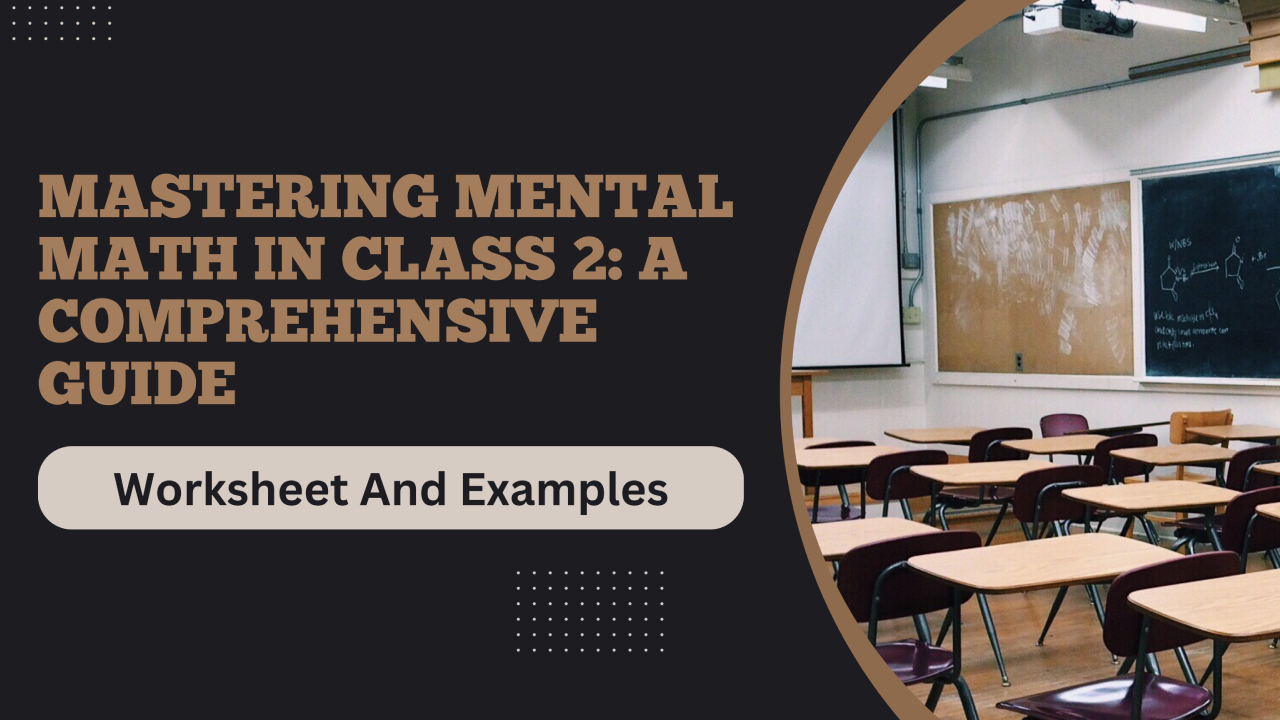Table of Contents
Young children can be taught to calculate mentally, which has a long-term impact on their performance in classes. For example, mental arithmetic for the second grade involves quick and accurate calculations within their minds without relying on calculators or written methods. Confidence is not the only advantage of this capacity but also it enhances problem-solving skills. In this blog, we will explore different techniques, strategies, and activities that can help children in class 2 understand how to do mental math better. Besides that, we will discuss why mental math should be taken seriously and how it can affect students both academically and in real life.
Importance of Mental Math
Besides that, we will discuss why mental math should be taken seriously and how it can affect students academically and in real life.
1. Enhances Numerical Fluency
The overall cognitive development of any child is affected by his ability to perform F. Mental maths helps youngsters become more fluent numerically so they can quickly see patterns and relationships between numbers. This fluidity is vital when tackling more intricate mathematical concepts in higher grades.
2. Boosts Confidence
Moreover, solving math problems orally makes children feel proud of themselves as well as boosts their self-confidence. Therefore, encouraging them through positive reinforcement further motivates them to engage more actively in mathematics-related activities.
3. Improves Problem-Solving Skills
An analytical approach leading to the solution arises from thinking critically about mental arithmetic; this encourages good problem-solving skills through logical thinking
4. Supports Everyday Math Skills
Mental arithmetic is an important life skill; it helps to calculate change in a shop and split bills. It involves performing everyday mathematical operations with minimal reliance on electronic devices.
5. Reduces Math Anxiety
Math anxiety can be reduced by regular mental math practice. As students become more familiar with numbers and basic arithmetic, there will be less tension or panic associated with mathematics tasks.
Techniques for Mastering Mental Math of Class 2
These are some mental techniques that Class 2 students can use to improve their abilities:
1. Counting On and Back
Counting up and down is a basic mental technique where one starts from some given number and then counts either forwards or backward from it. This method is especially useful in addition and subtraction exercises.
Example:
To add 7 + 5, start from 7 and count on five steps: 8, 9, 10, 11, 12. So, 7 + 5 = 12.
2. Using Number Bonds
A number bond consists of two numbers that sum up to give another number. Knowledge of these bonds facilitates the process of splitting numbers to subject them to the operations of addition or subtraction.
Example:
For the number 10, the number bonds are (1, 9), (2, 8), (3, 7), (4, 6), and (5, 5).
3. Doubles and Near Doubles
Recognizing doubles (e.g., 5 + 5) and near doubles (e.g., 5 + 6) makes it easier for students when they add numbers together. By adding or subtracting one, pupils can memorize double facts rapidly while adapting them for near doubles.
Example:
To solve 6 + 7, think of it as 6 + 6 + 1. Since 6 + 6 = 12, adding 1 gives 13. So, 6 + 7 = 13.
4. Making Ten
A strategy for making ten is helpful in addition problems. In this technique, students break down numbers to make a ten and then add the remaining.
Example:
To add 8 + 5, think of 8 + 2 = 10, and then add the remaining 3. So, 8 + 5 = 13.
5. Skip Counting
Skip counting is when you count by numbers other than one like twos, fives or tens. This method aids in multiplication, division, and understanding number patterns.
Example:
For multiplication, to find 4 x 3, skip count by fours: 4, 8, 12. So, 4 x 3 = 12.
6. Using Known Facts
Using known facts such as addition and subtraction up till ten for instance can help with speeding up mental calculations. By encouraging students to memorize these facts; it will create a solid foundation for them to apply more complex operations.
7. Breaking Down Numbers
It becomes easier to solve mental math problems if numbers are broken down into smaller more manageable parts. For bigger numbers, this method also called decomposition is especially useful.
Example:
To subtract 15 – 7, break it down: 15 – 5 = 10, then 10 – 2 = 8. So, 15 – 7 = 8.
8. Using the Commutative Property
The addition property of commutation says that summation does not change despite how one rearranges numbers. It is important to teach pupils the concept as it simplifies reordering figures during computations.
Example:
To add 3 + 9, students can think of it as 9 + 3 if that is easier for them.
Activities and Games for Practicing Mental Math
Mentally solving math questions becomes fun when students are involved in engaging activities and games. Here are a few examples:
1. Math Flashcards
Make flashcards that have addition, subtraction, and multiplication sums on them. Students should be asked to solve them rapidly with accuracy. Flashcards help remember mathematical facts fast leading to speed improvement
2. Math Bingo
Use math problems to play a game of bingo. Every student will be given a bingo card with numbers and the teacher will call out math problems which the students should solve and put their corresponding answers on their cards
3. Number Line Hop
Have students hop on a number line to arrive at the right answer for math questions. Counting on, counting back, and skip counting are reinforced through this physical activity.
4. Math Races
Plan mathematics races in which learners have to solve a set of mathematical problems as fast as possible. This competitive element adds enthusiasm thereby motivating them to enhance their speed and precision.
5. Interactive Math Apps
There are numerous educational applications designed to help students practice mental mathematics skills. These apps provide interactive ways that engage students when practicing arithmetic operations and solving problems.
6. Math Stories
Make stories an avenue where maths sums can be integrated. Students’ abilities to work out maths sums will be tested when fictional situations arise requiring them to find solutions. From such integration, maths is seen as being relevant and enjoyable.
7. Estimation Games
Ask kids to approximate the number of objects in a jar/ bottle or the length of something; estimation helps children gain sense of numbers while enhancing mental calculation skills too.
8. Math Puzzles
Give puzzles that require mental computations for solutions. Sudoku, cross-number puzzles, and math riddles are some of the puzzles that can challenge learners significantly.
Integrating Mental Math into Daily Routine
To make school seamless, it is important to include mental arithmetic in daily activities. Here are some different ways of incorporating mental mathematics into your everyday program:
1. Morning Math Warm-Up
First thing in the morning, have a brief mental math session. Let them mentally solve a few mathematical problems just to engage and prepare for learning.
2. Math in Everyday Situations
Relate math problems to real-life situations. For instance, you can ask learners to calculate the total cost of items during a pretend shopping activity or determine time left until break.
3. Math Challenges
Give students a daily or weekly math challenge that they can work on individually or in groups. These challenges can be puzzles, brain teasers, or word problems which require solving through mental maths.
4. Peer Teaching
Tell pupils to explain what they think about their classmates’ methods of mental arithmetic. This way, students reinforce their own understanding and share new techniques.
5. Math Journals
Let your students keep journals where they record their thought processes on paper as they work out arithmetic operations. The practice also fosters self-assessment and growth.
6. Math Centers
Organize several math centers with different tasks based on mental Math’s ideas. Rotate children between these centers so that they can do various things aiding their development in this sphere.
Supporting Parents and Caregivers
Parents and children’s caregivers have a crucial part to play in enhancing mental math skills at home. These tips will enable parents to help their children become experts in mental math:
1. Daily Practice
Encourage parents to engage their young ones in daily exercises of mental math. This could mean asking them arithmetic questions while driving or cooking.
2. Math Games at Home
Suggest enjoyable and educative mathematical games that can be played by family members together. Board games based on counting, addition, and subtraction are great options.
3. Positive Reinforcement
Advise parents to compliment their children’s performances and achievements in mental mathematics. Positive reinforcement helps boost one’s self-esteem thereby encouraging them to keep on practicing.
4. Incorporate Math in Everyday Activities
Propose ideas for how mathematics can be integrated into everyday activities such as measuring ingredients when cooking, counting things, talking about time, or discussing money.
5. Provide Resources
Provide links to some math apps, web resources or printable worksheets that parents can use while supporting the education of their kids at home.
Conclusion
Learning mental arithmetic in second grade is necessary for laying the foundation for math. Students can develop the skills they need to succeed by understanding why mental arithmetic is important, employing effective methods, engaging in activities, and connecting maths with daily life. Moreover, through fostering a supportive and nurturing surrounding by parents as well as care givers, children will have an opportunity to practice mental math. Consider these tactics and observe how your class 2 students will become confident and skilled regarding mental arithmetic thereby setting a platform for upcoming academic success and real-world survival techniques.

